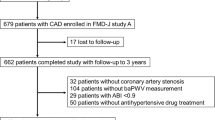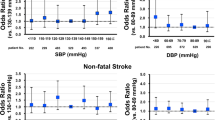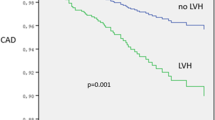Abstract
The increase in heart failure risk in the diabetic population when hypertension and atherosclerosis are both present is still inconclusive. The aim of this study was to explore the effects of hypertension combined with atherosclerosis in diabetic population on the risk of heart failure. We selected 10,711 patients with diabetes who participated in the Kailuan study and completed brachial-ankle pulse wave velocity (baPWV) testing for statistical analysis. The subjects were divided into the non-hypertensive non-atherosclerotic, hypertensive, atherosclerotic, and hypertensive atherosclerotic groups based on their history of hypertension and atherosclerosis. At a median follow-up of 4.15 years, 227 cases of heart failure occurred. Compared with the non-hypertensive non-atherosclerotic group, the multifactorial Cox proportional risk regression model showed that the hazard ratio (HR) for heart failure in the hypertensive atherosclerotic group was 3.08 (95% confidence interval [CI]: 1.32–7.16), whereas the HR decreased to 2.38 (95% CI: 1.01–5.63) after gradual correction of lipid-lowering, glucose-lowering, and antihypertensive drugs. The subgroup analysis and sensitivity analysis were consistent with that of total population. In conclusion, patients with diabetes exposed to both hypertension and atherosclerosis had an increased heart failure risk, which was attenuated by the use of lipid-lowering, glucose-lowering, and antihypertensive drugs.

This is a preview of subscription content, access via your institution
Access options
Subscribe to this journal
Receive 12 print issues and online access
$259.00 per year
only $21.58 per issue
Buy this article
- Purchase on Springer Link
- Instant access to full article PDF
Prices may be subject to local taxes which are calculated during checkout



Similar content being viewed by others
References
Hao G, Wang X, Chen Z, Zhang L, Zhang Y, Wei B, et al. Prevalence of heart failure and left ventricular dysfunction in China: the China Hypertension Survey, 2012–2015. Eur J Heart Fail. 2019;21:1329–37.
Wang H, Chai K, Du M, Wang S, Cai J, Li Y, et al. Prevalence and Incidence of Heart Failure Among Urban Patients in China: A National Population-Based Analysis. Circ Heart Fail. 2021;14:e008406.
Roger VL, Go AS, Lloyd-Jones DM, Benjamin EJ, Berry JD, Borden WB, et al. Heart disease and stroke statistics-2012 update: a report from the American Heart Association. Circulation. 2012;125:e2–e220.
Heidenreich PA, Albert NM, Allen LA, Bluemke DA, Butler J, Fonarow GC, et al. Forecasting the impact of heart failure in the United States: a policy statement from the American Heart Association. Circ Heart Fail. 2013;6:606–19.
Kannel WB, McGee DL. Diabetes and cardiovascular disease, The Framingham study,. JAMA. 1979;241:2035–8.
Chen G, McAlister FA, Walker RL, Hemmelgarn BR, Campbell NR. Cardiovascular outcomes in Framingham participants with diabetes: the importance of blood pressure. Hypertension. 2011;57:891–7.
Yasutaka M, Toyoshi I, Erina E, Yoshimi K, Shuji S, Noriyuki S, et al. Brachial-ankle pulse wave velocity predicts all-cause mortality and cardiovascular events in patients with diabetes: the Kyushu Prevention Study of Atherosclerosis. Diabetes Care. 2014;37:2383–90.
Jia W, Weng J, Zhu D, Ji L, Lu J, Zhou Z, et al. Standards of medical care for type 2 diabetes in China 2019. Diabetes Metab Res Rev. 2019;35:e3158.
Wu SL, Huang ZR, Yang XC, Zhou Y, Wang AX, Chen L, et al. Prevalence of ideal cardiovascular health and its relationship with the 4-year cardiovascular events in a northern Chinese industrial city. Circ Cardiovasc Qual Outcomes. 2012;5:487–93.
Inker LA, Schmid CH, Tighiouart H, Eckfeldt JH, Feldman HI, Greene T, et al. Estimating glomerular filtration rate from serum creatinine and cystatin C. N Engl J Med. 2012;367:20–29.
Zhou BF. Predictive values of body mass index and waist circumference for risk factors of certain related diseases in Chinese adults-study on optimal cut-off points of body mass index and waist circumference in Chinese adults. Biomed Environ Sci. 2002;15:83–96.
Thygesen K, Alpert JS, Jaffe AS, Chaitman BR, Bax JJ, Morrow DA, et al. Fourth Universal Definition of Myocardial Infarction (2018). J Am Coll Cardiol. 2018;72:2231–64.
Ivanova SA. Application of Minnesota ECG classifification code system amplifified by some quantitative code signs, in diagnostics of acquired vitium cordis and early phase of ischemic heart disease. Adv. Cardiol. 1977;19:257–8.
Chinese Joint Committee for the Revision of Guidelines for the Prevention and Treatment of dyslipidemia in adults. 2016 Chinese guideline for the management of dyslipidemia in adults, Chin. J Cardiol. 2016;44:833–853. (In Chinese)
Unger T, Borghi C, Charchar F, Khan NA, Poulter NR, Prabhakaran D, et al. 2020 International Society of Hypertension Global Hypertension Practice Guidelines. Hypertension. 2020;75:1334–57.
Whelton PK, Carey RM, Aronow WS, Casey Jr DE, Collins KJ, Himmelfarb CD, et al. 2017ACC/AHA guideline for the prevention, detection, evaluation, and management of high blood pressure in adults: A report of the American College of Cardiology/American heart association task force on clinical practice guidelines. Hypertension. 2018;71:e13–e115.
Heart Failure Group of Chinese Society of Cardiology of Chinese Medical Association. Chinese heart failure association of chinese medical doctor association; editorial board of Chinese journar of cardioloy. the guidelines for diagnosis and treatment of heart failure in China in 2018 Chin J Heart Fail Cardio. 2018;4:196–225.
Niiranen TJ, Kalesan B, Hamburg NM, Benjamin EJ, Mitchell GF, Vasan RS. Relative Contributions of Arterial Stiffness and Hypertension to Cardiovascular Disease: The Framingham Heart Study. J Am Heart Assoc. 2016;5:e004271.
Wu YT, Zhang YJ, Gao JS, Man SL, Xing JN, Cao ZW, et al. Effect of brachial-ankle pulse wave velocity combined with blood pressure on cardio-cerebrovascular events. Exp Ther Med. 2019;18:4555–66.
Cholesterol Treatment Trialists’ (CTT) Collaborators, Kearney PM, BlackwellL, Collins R, Keech A, Simes J, Peto R, et al. Efficacy of cholesterol-lowering therapy in 18,686 people with diabetes in 14 randomised trials of statins: a meta-analysis,. Lancet. 2008;371:117–25.
Ettehad D, Emdin CA, Kiran A, Anderson SG, Callender T, Emberson J, et al. Blood pressure lowering for prevention of cardiovascular disease and death: a systematic review and meta-analysis. Lancet. 2016;387:957–67.
Intensive blood-glucose control with sulfonylureas or insulin compared with conventional treatment and risk of complications in patients with type 2 diabetes (UKPDS 33). UK Prospective Diabetes Study (UKPDS) Group. Lancet. 1998;352:837–53.
Wright JT Jr, Williamson JD, Whelton PK, Snyder JK, Sink KM, Rocco MV, et al. A randomized trial of intensive versus standard blood-pressure control. N Engl J Med. 2015;373:2103–16.
Ambrosius WT, Sink KM, Foy CG, Berlowitz DR, Cheung AK, Cushman WC, et al. SPRINT Study Research Group. The design and rationale of a multicenter clinical trial comparing two strategies for control of systolic blood pressure: the Systolic Blood Pressure Intervention T rial (SPRINT). Clin Trials. 2014;11:532–46.
Zhou YF, Wang Y, Wang G, Zhou Z, Chen S, Geng T, et al. Association Between Statin Use and Progression of Arterial Stiffness Among Adults With High Atherosclerotic Risk. JAMA. 2022;5:e2218323.
Zheng HW, Wu SL, Liu XK, Qiu GY, Chen SH, Wu YT, et al. Association Between Arterial Stiffness and New-Onset Heart Failure: The Kailuan Study. Arterioscler Thromb Vasc Biol. 2023;43:e104–e111.
Sung MK, Gyeongsil L, Seulggie C, Kim K, Jeong SM, Son JS, et al. Association of early-onset diabetes, prediabetes and early glycaemic recovery with the risk of all-cause and cardiovascular mortality. Diabetologia. 2020;63:2305–14.
Hu C, Lin L, Zhu Y, Zhang Y, Wang S, Zhang J, et al. Association Between Age at Diagnosis of Type 2 Diabetes and Cardiovascular Diseases: A Nationwide, Population-Based, Cohort Study. Front Endocrinol (Lausanne). 2021;12:717069.
Wang C, Yuan Y, Zheng M, Pan A, Wang M, Zhao M, et al. Association of Age of Onset of Hypertension With Cardiovascular Diseases and Mortality. J Am Coll Cardiol. 2020;75:2921–30.
Ho JE, Lyass A, Lee DS, Vasan RS, Kannel WB, Larson MG, et al. Predictors of new-onset heart failure: differences in preserved versus reduced ejection fraction. Circ Heart Fail. 2013;6:279–86.
Pagidipati NJ, Zheng YG, Green JB, McGuire DK, Mentz RJ, Shah S, et al. Association of obesity with cardiovascular outcomes in patients with type 2 diabetes and cardiovascular disease: Insights from TECOS. Am Heart J. 2020;219:47–57.
Thomas G, Khunti K, Curcin V, Molokhia M, Millett C, Majeed A, et al. Obesity paradox in people newly diagnosed with type 2 diabetes with and without prior cardiovascular disease. Diabetes Obes Metab. 2014;16:317–25.
Uretsky S, Messerli FH, Bangalore S, Champion A, Cooper-Dehoff RM, Zhou Q, et al. Obesity paradox in patients with hypertension and coronary artery disease. Am J Med. 2007;120:863–70.
Vestberg D, Rosengren A, Olsson M, Gudbjörnsdottir S, Haraldsson B, Svensson AM, et al. Decreased eGFR as a Risk Factor for Heart Failure in 13 781 Individuals With Type 1 Diabetes. J Diabetes Sci Technol. 2015;10:131–6.
Tancredi M, Rosengren A, Olsson M, Gudbjörnsdottir S, Svensson AM, Haraldsson B, et al. The relationship between three eGFR formulas and hospitalization for heart failure in 54 486 individuals with type 2 diabetes. Diabetes Metab Res Rev. 2016;32:730–5.
Whelton PK, Carey RM, Aronow WS, Casey DE Jr, Collins KJ, Dennison Himmelfarb C, et al. 2017 ACC/AHA Guideline for the Prevention, Detection, Evaluation, and Management of High Blood Pressure in Adults: Executive Summary: A Report of the American College of Cardiology/American Heart Association Task Force on Clinical Practice Guidelines. Hypertension. 2018;71:1269–324.
Costa-Hong VA, Muela HCS, Macedo TA, Sales ARK, Bortolotto LA. Gender differences of aortic wave reflection and influence of menopause on central blood pressure in patients with arterial hypertension. BMC Cardiovasc Disord. 2018;18:123.
Lu Y, Pechlaner R, Cai J, Yuan H, Huang Z, Yang G, et al. Trajectories of Age-Related Arterial Stiffness in Chinese Men and Women. J Am Coll Cardiol. 2020;75:870–80.
Saeed A, Kampangkaew J, Nambi V. Prevention of Cardiovascular Disease in Women. Methodist Debakey Cardiovasc J. 2017;13:185–92.
Chirinos J, Segers P, Hughes T, Townsend R. Large-artery stiffness in health and disease: JACC state-of-the-art review. J Am Coll Cardiol. 2019;74:1237–63.
Franz HM, Stefano FR, Sripal B. The Transition From Hypertension to Heart Failure: Contemporary Update. JACC Heart Fail. 2017;5:543–51.
Sonia MR, Ana B, María S, Varona S, Palao T, Orriols M, et al. Lysyl oxidase induces vascular oxidative stress and contributes to arterial stiffness and abnormal elastin structure in hypertension:role of p38MAPK. Antioxid Redox Signal. 2017;27:379–97.
Hashimoto J, Westerhof BE, Westerhof N, Imai Y, O’Rourke MF. Different role of wave reflection magnitude and timing on left ventricular mass reduction during antihypertensive treatment. J Hypertens. 2008;26:1017–24.
Zamani P, Bluemke DA, Jacobs DR Jr, Duprez DA, Kronmal R, Lilly SM, et al. Resistive and pulsatile arterial load as predictors of left ventricular mass and geometry: the multi-ethnic study of atherosclerosis. Hypertension. 2015;65:85–92.
Gillebert TC, Leite-Moreira AF, De Hert SG. Load dependent diastolic dysfunction in heart failure. Heart Fail Rev. 2000;5:345–55.
Chirinos JA. Large Artery Stiffness, Microvascular Function, and Cardiovascular Risk. Circ Cardiovasc Imaging. 2016;9:e005903.
Levy BI, Ambrosio G, Pries AR, Struijker-Boudier HA. Microcirculation in Hypertension, A New Target for Treatment? Circulation. 2001;104:735–40.
Acknowledgements
We thank all study participants, their relatives, the members of the survey teams at the 11 regional hospitals of the Kailuan Medical Group; and the project development and management teams at the Shanghai General Hospital and the Kailuan Group.
Funding
The work for this article was supported by National Natural Scientifc Funding of China (No 82070335 & No 81570293) and the National Key R&D Program (2020YFC2004703).
Author information
Authors and Affiliations
Contributions
LW conducted the statistical analysis, interpreted the data and drafted the manuscript. JG performed the experiments and interpreted the data. JZ revising the manuscript for intellectual content. MW, SC, GW and LH interpreted the data. Shouling Wu, and Jiang Hong had full access to all the data and take responsibility for the integrity of the data and the accuracy of the data analysis.
Corresponding authors
Ethics declarations
Conflict of interest
The authors declare no competing interests.
Additional information
Publisher’s note Springer Nature remains neutral with regard to jurisdictional claims in published maps and institutional affiliations.
Supplementary information
Rights and permissions
Springer Nature or its licensor (e.g. a society or other partner) holds exclusive rights to this article under a publishing agreement with the author(s) or other rightsholder(s); author self-archiving of the accepted manuscript version of this article is solely governed by the terms of such publishing agreement and applicable law.
About this article
Cite this article
Wu, L., Gao, J., Zhuang, J. et al. Hypertension combined with atherosclerosis increases the risk of heart failure in patients with diabetes. Hypertens Res 47, 921–933 (2024). https://doi.org/10.1038/s41440-023-01529-y
Received:
Revised:
Accepted:
Published:
Issue Date:
DOI: https://doi.org/10.1038/s41440-023-01529-y



